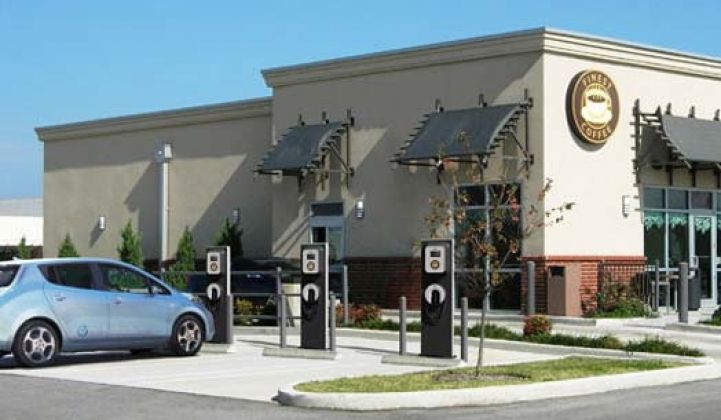Besides being the world’s single largest deployment of EV charging infrastructure in the world, the Department of Energy’s $230 million EV Project is also a huge data collection engine. Indeed, one of the key goals of the government-industry partnership is to learn everything there is to know about how plug-in vehicles interact with the grid -- and how plug-in owners deal with using the grid as a gas station.
ECOtality, as contractor for the EV Project's 5,000 residential chargers and 2,000 commercial chargers, just hit another milestone, announcing this week that it has passed 1 million “charge events” -- single instances of a Chevy Volt or Nissan Leaf being plugged into the power grid.
ECOtality has been tallying up driver miles for years now, recently reaching the 40-million-mile mark, as drivers in cities across the country keep plugging in and giving the project their data.
So what can 1 million charge events tell us? Steve Schey, director of stakeholder services for ECOtality, took time to answer some questions via email, and explains what insights are to be gleaned from this milestone.
GTM: What are the most notable things you've discovered in the course of racking up 1 million charge events?
Schey: Since the beginning of the project, we’ve consistently seen that most EV charging happens at home. While we still expect the majority of charging to take place at home, we’re excited to see that in the past three months, public charging has increased by 25 percent. This shows that drivers are becoming more and more comfortable with stretching the range of their vehicles and utilizing the public infrastructure available. The cities with the greatest increases in charging away from home were Los Angeles, Tucson and Memphis, with San Diego, Oregon and Houston also showing significant increases. Overall, cities where drivers are going the farthest distances between charges are San Francisco, Knoxville and Chattanooga.
We’ve also seen differences between average number of charge events per day between the Volt and Leaf. Nissan Leaf drivers charge 1.1 times per day, while Volt drivers charge 1.5 times, indicating the Volt drivers are interested in keeping their vehicles out of the traditional gas combustion engine mode.
GTM: What behavioral data have you discovered?
Schey: EV drivers still primarily charge their vehicles at home, but as public infrastructure options expand they are charging their vehicles away from home more often. Recharge times are short, but we are experiencing increases. Average home recharge time has increased from 1 hour to 30 minutes per day to 1 hour and 48 minutes per day. With greater driving distances come longer recharge times.
GTM: What have you learned about what people are willing to pay for different charging experiences?
Schey: We are just starting to roll out our pricing fees and therefore do not yet have adequate data to draw conclusions about what drivers are willing to pay. However, we can say from the time-of-use rates available in select cities that price signals do work. Drivers in these regions charge more often during the low peak periods than other times during the day to minimize their electricity bill.
From a host-site perspective, we know that retailers in particular benefit from offering EV charging services. Data show that EV drivers are three times as more likely to return to a store with an EV charging station than one without. In addition to retailers, hotels have emerged as an ideal charge location, and we have a number of deals with hotels in the works.



